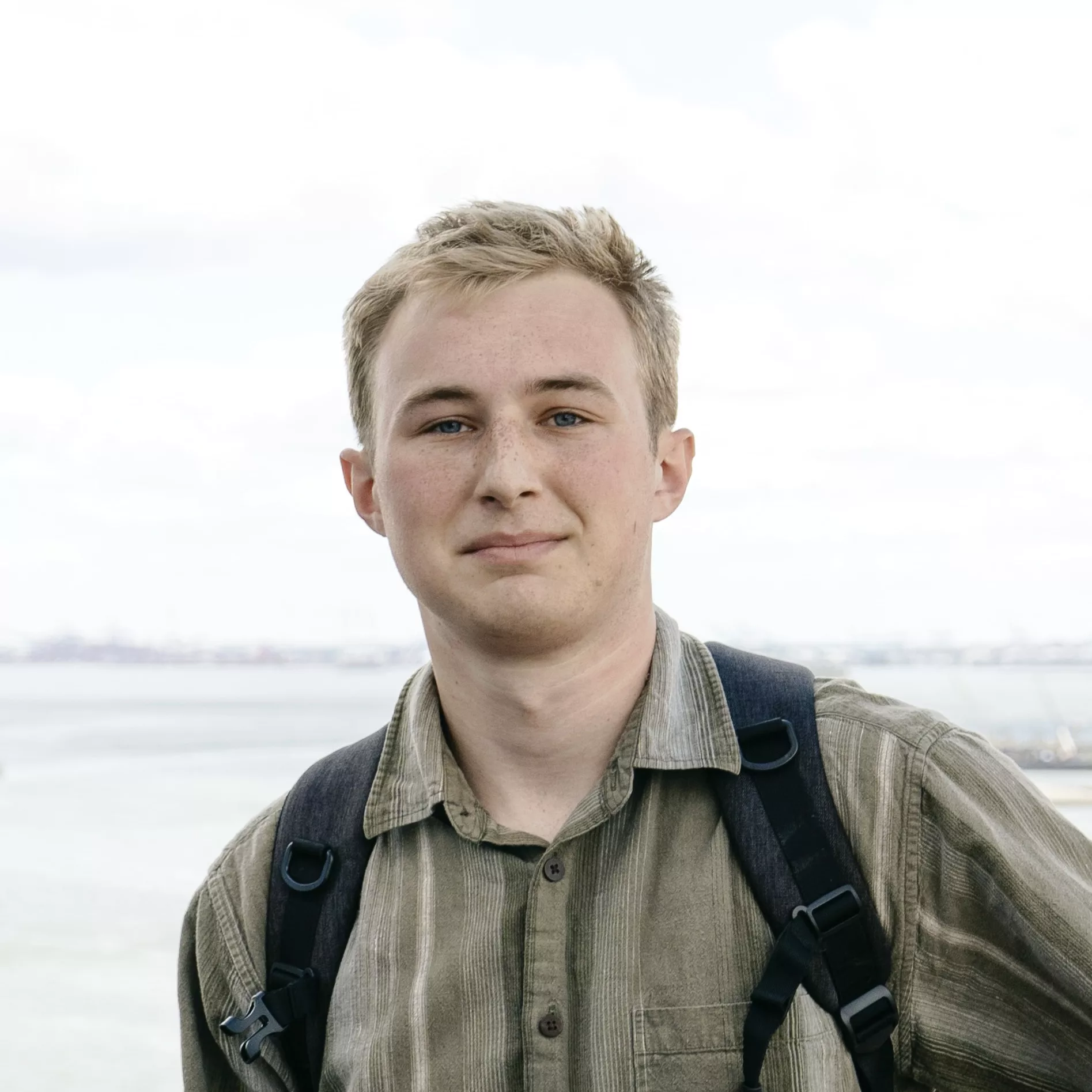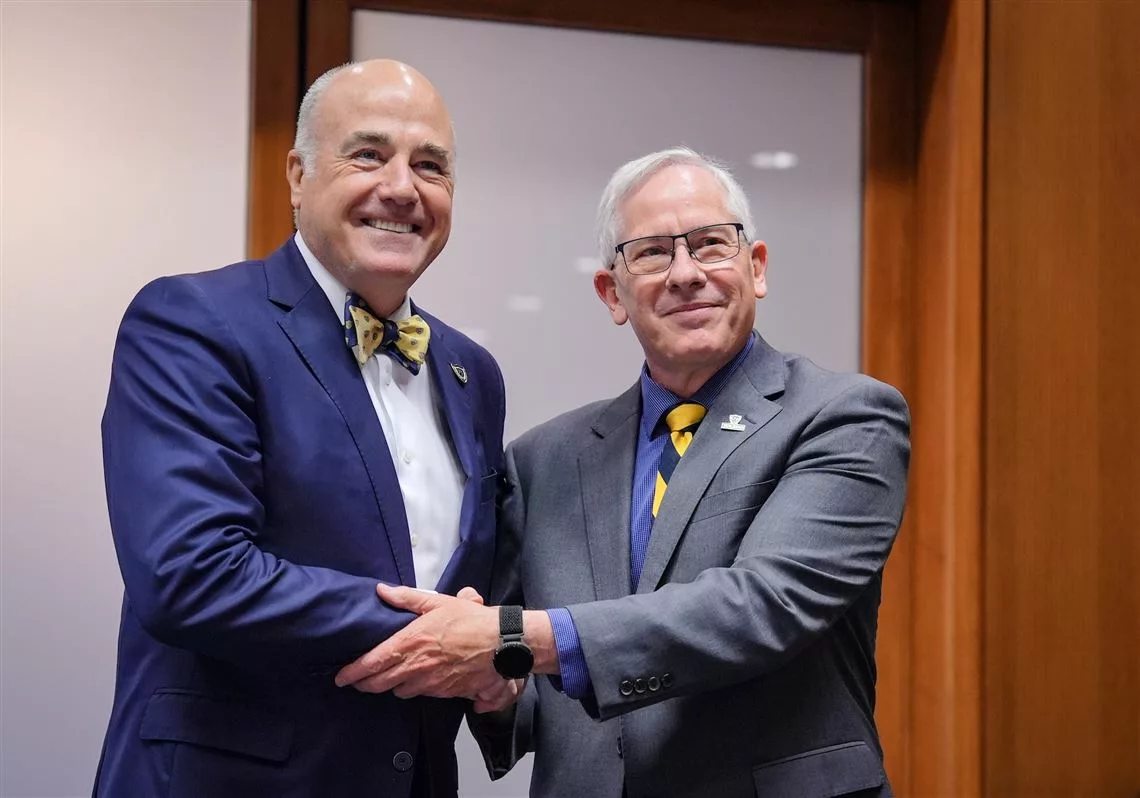The University of Toledo’s 19th president, James Holloway, was selected Thursday to “restore the greatness” of the university and build upon research growth amid declining enrollment.
Mr. Holloway will take the helm July 15, leaving his position as provost and executive vice president for academic affairs at the University of New Mexico, a post he has held since July, 2019. UNM is that state’s largest university with 23,228 students at its Albuquerque campus.
UT’s board of trustees announced his hiring at a special meeting Thursday morning.
“There’s no question that Dr. Holloway, from day one, rose right to the top in our considerations,” said Patrick Kenney, UT trustee and co-chairman of the search committee.
“He was going to be a president somewhere. We’re glad he’s our president, and we feel very fortunate to have attracted him here to this job and this opportunity,” said Stephen P. Ciucci, trustee and the search committee’s other co-chairman.
“We think James [Holloway] is the right person to restore the greatness of the University of Toledo, and we think he will position us nicely for growth, for stability, and for impact both regionally and nationally,” he said.
From 2007 to 2019, Mr. Holloway held a number of positions at the University of Michigan, serving as associate dean for undergraduate education, vice provost for global and engaged education, and vice provost for global engagement and interdisciplinary academic affairs. He is also professor emeritus of nuclear engineering and radiological sciences.
The 65-year-old will succeed Dr. Gregory Postel, who left UT in May, 2024, to accept the position of senior vice president of health affairs and dean of the college of medicine at the University of Cincinnati. Matt Schroeder has served as the university’s interim president since April, 2024, and will return to his former position as executive vice president for finance and administration and CFO.
Mr. Holloway holds a doctorate degree in engineering physics from the University of Virginia and master’s and bachelor’s degrees in nuclear engineering from the University of Illinois. He also holds a certificate in advanced-study in mathematics from Cambridge University in England.
During his five-year contract, Mr. Holloway will be paid a base salary of $625,000. The board may also award him a yearly performance bonus of up to 30 percent of his salary. He will also be appointed as a professor in UT’s college of engineering, and may continue in that role after his presidency.
Booming enrollment
Mr. Ciucci said Mr. Holloway’s immediate success in reversing UNM’s decade-long enrollment decline set him apart from other candidates. Over five years at UNM, the number of first-year students increased by 40 percent and total enrollment grew by 7 percent.
“Our biggest challenge right now is enrollment — we have to turn that decline around and rebuild our enrollment,” Mr. Ciucci said. “James [Holloway] has a very strong track record of improving enrollment, improving student success outcomes, and improving retention, and all of that was very important for us.”
Mr. Holloway said consistently communicating the value of an education at the university is key to the increase, and that he wants students and family members to be “excited” about pursuing an education at UT.
“I like challenges, and the University of Toledo has an enrollment challenge. I know it can be turned around,” Mr. Holloway said. “It’s about making the value proposition of the university really clear to prospective students, … but fundamentally it’s about knowing that there is a value proposition there.”
At the University of Michigan, Mr. Holloway strengthened the university’s connection with Detroit. He believes the university has the ability to play a key role in Toledo’s growth by embracing its status in the community.
“It’s first about being a good neighbor. The University of Toledo is a large institution — it’s a significant part of the city. It doesn’t exist for itself, it exists for the city,” Mr. Holloway said. “And in a time when people have questions about the value of higher education … I think it’s really critical that universities lean back into that mission of being about the people who support them.”
The trustees and Mr. Holloway thanked Mr. Schroeder for his leadership during the presidential search.
“We need to give credit to folks already at the University of Toledo, Matt Schroeder certainly first among those, for building the foundation on which we can keep moving forward,” Mr. Holloway said.
Building up research
At the University of New Mexico, Mr. Holloway oversaw the research and academic activities of the state’s flagship public university, which holds an R1 classification. The University of Toledo earned its R1 designation in February, and trustees said accelerating research was another priority in its search for a president.
Mr. Holloway said research is a “critically important” focus area at UT, and he plans to continue building out the university’s research infrastructure. At the University of New Mexico, research expenditures grew by 46 percent under Mr. Holloway’s leadership. He said the presence of large industry in Toledo is an asset that could fuel that growth locally.
“One thing I think is really important in Toledo is looking for opportunities to do research with the local industry, with the local manufacturers, and with the the local businesses,” he said. “Throughout the U.S., the fastest-growing source of research funding has actually been companies … and we really want to work in partnership with those companies to develop that research capacity as well.”
The trustees believe Mr. Holloway has the experience necessary to continue fueling the growth of research as the university gains recognition for its activities.
His own research is in computational and mathematical modeling with applications in areas such as neutron and photon radiation transport theory, inverse problems, and uncertainty quantification. He served as a professor of nuclear engineering at the University of New Mexico, and is a professor emeritus of nuclear engineering and radiological sciences and Arthur F. Thurnau professor emeritus at the University of Michigan.
“[Mr. Holloway’s] entire background has been at R1 institutions … five times the size of us, from a research funding standpoint,” Mr. Ciucci said. “Great research attracts great faculty, which attracts great students.”
At the University of New Mexico, Mr. Holloway and the university’s leadership have faced pushback over its recent handling of a pro-Palestine encampment and unionization efforts of faculty and graduate students, according to the university’s student newspaper, the Daily Lobo.
A letter signed by 225 faculty members urged the university’s president and Mr. Holloway to “de-escalate their response towards students exercising their first amendment rights and urges restraint in meting out discipline” after 16 students were arrested. In 2021, the university’s leadership pushed back on a unionization effort by graduate students.
Connecting with medicine
Integrating the university’s medical center with its academics is crucial in strengthening the community, Mr. Holloway said. Both the University of Michigan and University of New Mexico have large health systems, and Mr. Holloway told The Blade he chaired the search for an executive vice president to lead UNM’s health system.
“One of the things we realized is that there’s so much we can do if we integrate the university across the health system, the medical school, and the academic campus of the university,” Mr. Holloway said.
The University of Toledo Medical Center provides advanced care to the region and is northwest Ohio’s only transplant center.
“As a university with an academic health center, we have to critically recognize our role in the provision of health care to the region. The University of Toledo, through the health system, is providing tertiary, quaternary care that’s critical to the people of the region,” Mr. Holloway said.
“So that’s one of our responsibilities: to make sure that we’re doing that at a really high level, doing that in a way that is accessible to folks, and finding ways to grow the health-care system and the health-care work force in our system and others,” he continued.
Midwestern roots
Mr. Holloway was born in Washington, D.C., into an Army family. He told The Blade he grew up as an “Army brat” and has lived in Thailand, Germany, and five different U.S. states. He is married to his wife, Johnna, and has an adult son, Patrick.
“He has very strong Midwestern roots and values, so he’s coming back home, if you will,” Mr. Ciucci said. “All of us Midwesterners love the Midwestern work ethic and values, which we believe James [Holloway] will bring here to the university.”
Living abroad early in his life gave him an appreciation for difference cultures, which he has carried throughout his career. His work has been a mix of research, teaching, administration, and global work, including in India, Ethiopia, and Ghana. He spent 29 years of his career at the University of Michigan and said he is familiar with the Toledo area.
“The longest I lived anywhere was when I was at the University of Michigan, a little ways north,” Mr. Holloway said. “We used to come down to Toledo and go to COSI — I guess it’s called Imagination Station now — we’d go to the Toledo Zoo, and the art museum frequently, so we had those connections.”
Search for a superstar
The selection of Mr. Holloway concludes a seven-month search that started in October, in which the board of trustees engaged with internal and external stakeholders. The board contracted with Education Executives, which helped Ohio State University identify its current president, for the national search.
Dozens of candidates from across the country were interviewed by the trustees, and Mr. Kenney said Mr. Holloway emerged as a “superstar” among a field of the “best and the brightest” leaders in higher education.
According to Mr. Ciucci, an initial interview with Mr. Holloway lasted about an hour and the second interview lasted “a couple of hours.” Mr. Holloway also visited UT’s campus for about a day and a half and engaged in discussions with trustees throughout the process.
Mr. Holloway was announced as one of three finalists for the University of Minnesota’s top post in early February, but another candidate was selected later that month.
Mr. Ciucci said Mr. Holloway’s recognition as a finalist to lead a Big 10 university was “one very important data point” in the UT trustees’ decision.
Members of UT’s search committee — co-chaired by Mr. Kenney and Mr. Ciucci — include Pat Bowe, chairman and former president and CEO of The Andersons; Randy Gardner, former Ohio Department of Higher Education chancellor; and Joe Napoli, president and CEO of Toledo Mud Hens and Walleye. Drs. Ilene H. Nagel and John D. Simon led the firm’s consultant team.
Faculty members on the committee include Jerry Van Hoy, faculty senate president, associate professor of sociology, co-director of the program in law and social thought, and director of the master of liberal studies program; Frank Calzonetti, vice president for innovation and economic development; and Dr. Shaza Aouthmany, emergency medicine physician and associate dean of graduate and continuing medical education in the college of medicine and life sciences.
In addition to trustees Eleanore Awadalla, Alfred A. Baker, Lidia B. Ebersole, Zac Isaac, Adam Levine, and Michael R. Miller, the committee includes Dr. Thomas Wakefield, national trustee, and Kevin Bishop and Nate Boley, student trustees.

